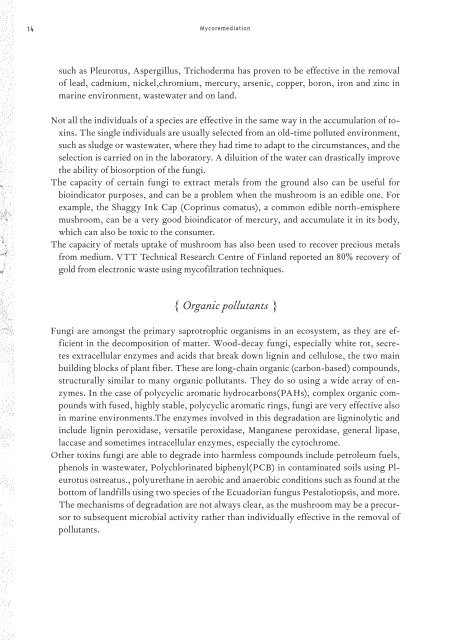Logbuch_17x24Druck_einzelseiten
You also want an ePaper? Increase the reach of your titles
YUMPU automatically turns print PDFs into web optimized ePapers that Google loves.
14<br />
Mycoremediation<br />
such as Pleurotus, Aspergillus, Trichoderma has proven to be effective in the removal<br />
of lead, cadmium, nickel,chromium, mercury, arsenic, copper, boron, iron and zinc in<br />
marine environment, wastewater and on land.<br />
Not all the individuals of a species are effective in the same way in the accumulation of toxins.<br />
The single individuals are usually selected from an old-time polluted environment,<br />
such as sludge or wastewater, where they had time to adapt to the circumstances, and the<br />
selection is carried on in the laboratory. A diluition of the water can drastically improve<br />
the ability of biosorption of the fungi.<br />
The capacity of certain fungi to extract metals from the ground also can be useful for<br />
bioindicator purposes, and can be a problem when the mushroom is an edible one. For<br />
example, the Shaggy Ink Cap (Coprinus comatus), a common edible north-emisphere<br />
mushroom, can be a very good bioindicator of mercury, and accumulate it in its body,<br />
which can also be toxic to the consumer.<br />
The capacity of metals uptake of mushroom has also been used to recover precious metals<br />
from medium. VTT Technical Research Centre of Finland reported an 80% recovery of<br />
gold from electronic waste using mycofiltration techniques.<br />
{ Organic pollutants }<br />
Fungi are amongst the primary saprotrophic organisms in an ecosystem, as they are efficient<br />
in the decomposition of matter. Wood-decay fungi, especially white rot, secretes<br />
extracellular enzymes and acids that break down lignin and cellulose, the two main<br />
building blocks of plant fiber. These are long-chain organic (carbon-based) compounds,<br />
structurally similar to many organic pollutants. They do so using a wide array of enzymes.<br />
In the case of polycyclic aromatic hydrocarbons(PAHs), complex organic compounds<br />
with fused, highly stable, polycyclic aromatic rings, fungi are very effective also<br />
in marine environments.The enzymes involved in this degradation are ligninolytic and<br />
include lignin peroxidase, versatile peroxidase, Manganese peroxidase, general lipase,<br />
laccase and sometimes intracellular enzymes, especially the cytochrome.<br />
Other toxins fungi are able to degrade into harmless compounds include petroleum fuels,<br />
phenols in wastewater, Polychlorinated biphenyl(PCB) in contaminated soils using Pleurotus<br />
ostreatus., polyurethane in aerobic and anaerobic conditions such as found at the<br />
bottom of landfills using two species of the Ecuadorian fungus Pestalotiopsis, and more.<br />
The mechanisms of degradation are not always clear, as the mushroom may be a precursor<br />
to subsequent microbial activity rather than individually effective in the removal of<br />
pollutants.


